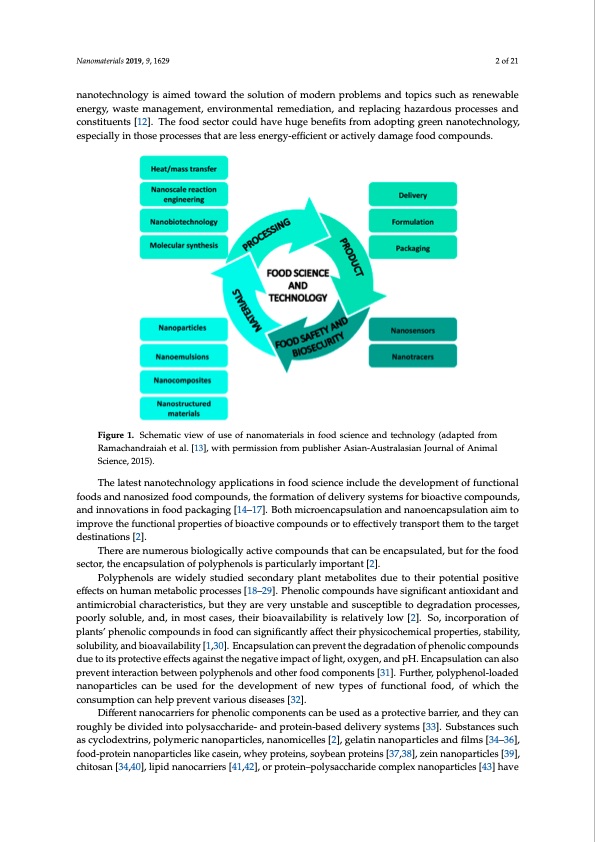
PDF Publication Title:
Text from PDF Page: 002
Nanomaterials 2019, 9, x FOR PEER REVIEW 2 of 23 Nanomaterials 2019, 9, 1629 2 of 21 carriers [10,11]. Green nanotechnology is aimed toward the solution of modern problems and topics nsuanchoteacshnroelnoegwy aisblaeimeendertgoyw, awrdasthte smolauntaiognemofenmt,odeenrvnirpornomblenmtasl anredmteodpiactsiosnu,chanasd rerneepwlaacbinleg ehnaezragryd,owusasptreomceassneasgaenmdecnot,nsetnitvuireonntsm[e1n2]t.aTl hremfoeoddiasteiocnto,racnodulrdephlavceinhguhgaezbaerndeofuits pfrromceassdeospatindg cgorneestnitnuaenotste[c1h2n].olTohgye,feosopdecsieacltlyorincothuoldsehparvoecehsusgesetbheanteafiretslefrsosmenaedrgoyp-teifnfigcigerneteonrnaactniovteelychdnaomloagye, efospoedcciaolmlypinouthnodse. processes that are less energy-efficient or actively damage food compounds. Figure 1. Schematic view of use of nanomaterials in food science and technology (adapted from Figure 1. Schematic view of use of nanomaterials in food science and technology (adapted from Ramachandraiah et al. [13], with permission from publisher Asian-Australasian Journal of Animal Ramachandraiah et al. [13], with permission from publisher Asian-Australasian Journal of Animal Science, 2015). Science, 2015). The latest nanotechnology applications in food science include the development of functional The latest nanotechnology applications in food science include the development of functional foods and nanosized food compounds, the formation of delivery systems for bioactive compounds, foods and nanosized food compounds, the formation of delivery systems for bioactive compounds, and innovations in food packaging [14–17]. Both microencapsulation and nanoencapsulation aim to and innovations in food packaging [14–17]. Both microencapsulation and nanoencapsulation aim to improve the functional properties of bioactive compounds or to effectively transport them to the target improve the functional properties of bioactive compounds or to effectively transport them to the destinations [2]. target destinations [2]. There are numerous biologically active compounds that can be encapsulated, but for the food There are numerous biologically active compounds that can be encapsulated, but for the food sector, the encapsulation of polyphenols is particularly important [2]. sector, the encapsulation of polyphenols is particularly important [2]. Polyphenols are widely studied secondary plant metabolites due to their potential positive Polyphenols are widely studied secondary plant metabolites due to their potential positive effects on human metabolic processes [18–29]. Phenolic compounds have significant antioxidant and effects on human metabolic processes [18–29]. Phenolic compounds have significant antioxidant and antimicrobial characteristics, but they are very unstable and susceptible to degradation processes, antimicrobial characteristics, but they are very unstable and susceptible to degradation processes, poorly soluble, and, in most cases, their bioavailability is relatively low [2]. So, incorporation of poorly soluble, and, in most cases, their bioavailability is relatively low [2]. So, incorporation of plants’ phenolic compounds in food can significantly affect their physicochemical properties, stability, plants’ phenolic compounds in food can significantly affect their physicochemical properties, solubility, and bioavailability [1,30]. Encapsulation can prevent the degradation of phenolic compounds stability, solubility, and bioavailability [1,30]. Encapsulation can prevent the degradation of phenolic due to its protective effects against the negative impact of light, oxygen, and pH. Encapsulation can also compounds due to its protective effects against the negative impact of light, oxygen, and pH. prevent interaction between polyphenols and other food components [31]. Further, polyphenol-loaded Encapsulation can also prevent interaction between polyphenols and other food components [31]. nanoparticles can be used for the development of new types of functional food, of which the Further, polyphenol-loaded nanoparticles can be used for the development of new types of consumption can help prevent various diseases [32]. functional food, of which the consumption can help prevent various diseases [32]. Different nanocarriers for phenolic components can be used as a protective barrier, and they can Different nanocarriers for phenolic components can be used as a protective barrier, and they roughly be divided into polysaccharide- and protein-based delivery systems [33]. Substances such can roughly be divided into polysaccharide- and protein-based delivery systems [33]. Substances as cyclodextrins, polymeric nanoparticles, nanomicelles [2], gelatin nanoparticles and films [34–36], such as cyclodextrins, polymeric nanoparticles, nanomicelles [2], gelatin nanoparticles and films [34– food-protein nanoparticles like casein, whey proteins, soybean proteins [37,38], zein nanoparticles [39], 36], food-protein nanoparticles like casein, whey proteins, soybean proteins [37,38], zein chitosan [34,40], lipid nanocarriers [41,42], or protein–polysaccharide complex nanoparticles [43] have nanoparticles [39], chitosan [34,40], lipid nanocarriers [41,42], or protein–polysaccharide complexPDF Image | Polyphenol-Loaded Nanoparticles in Food Industry

PDF Search Title:
Polyphenol-Loaded Nanoparticles in Food IndustryOriginal File Name Searched:
nanomaterials-09-01629.pdfDIY PDF Search: Google It | Yahoo | Bing
Turbine and System Plans CAD CAM: Special for this month, any plans are $10,000 for complete Cad/Cam blueprints. License is for one build. Try before you buy a production license. More Info
Waste Heat Power Technology: Organic Rankine Cycle uses waste heat to make electricity, shaft horsepower and cooling. More Info
All Turbine and System Products: Infinity Turbine ORD systems, turbine generator sets, build plans and more to use your waste heat from 30C to 100C. More Info
CO2 Phase Change Demonstrator: CO2 goes supercritical at 30 C. This is a experimental platform which you can use to demonstrate phase change with low heat. Includes integration area for small CO2 turbine, static generator, and more. This can also be used for a GTL Gas to Liquids experimental platform. More Info
Introducing the Infinity Turbine Products Infinity Turbine develops and builds systems for making power from waste heat. It also is working on innovative strategies for storing, making, and deploying energy. More Info
Need Strategy? Use our Consulting and analyst services Infinity Turbine LLC is pleased to announce its consulting and analyst services. We have worked in the renewable energy industry as a researcher, developing sales and markets, along with may inventions and innovations. More Info
Made in USA with Global Energy Millennial Web Engine These pages were made with the Global Energy Web PDF Engine using Filemaker (Claris) software.
Infinity Turbine Developing Spinning Disc Reactor SDR or Spinning Disc Reactors reduce processing time for liquid production of Silver Nanoparticles.
| CONTACT TEL: 608-238-6001 Email: greg@infinityturbine.com | RSS | AMP |